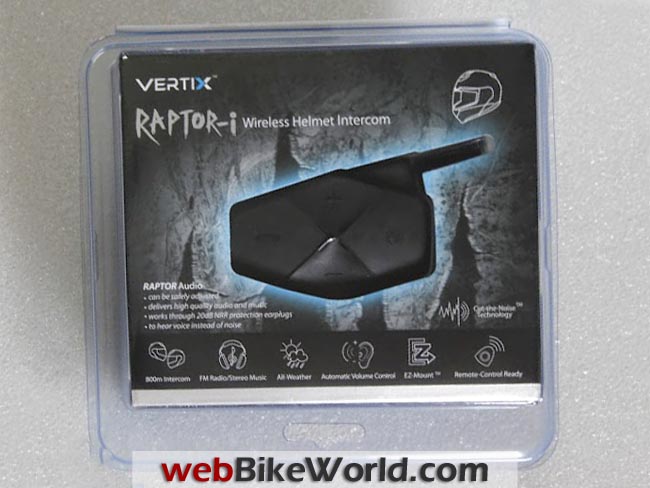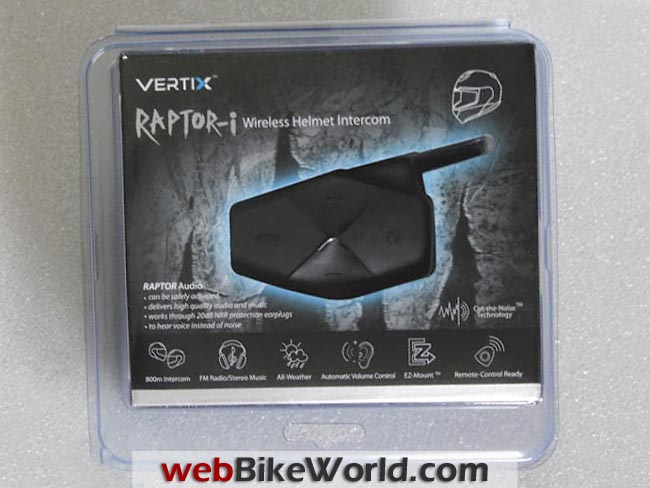The Vertix Raptor-i is a new motorcycle intercom from a wireless technology company based in Singapore.
The Vertix Raptor-i delivers all of the features expected of a “new generation” Bluetooth device at a competitive price.
Plus, it has some very interesting add-ons in the pipeline…
Keeping tabs on the motorcycle intercom market certainly hasn’t been easy of late.
A few years ago, intercom systems in general were limited in both range and function.
But as Bluetooth technology has progressed, many manufacturers have been quick to take advantage of its vastly improved functionality while adding their own extra features to the mix.
A modern motorcycle intercom is expected to let you talk to your mates at legal speeds, take phone calls, as well as channeling GPS voice guidance along with streamed music or FM radio for entertainment.
The newest company to venture into this arena is Vertix, a wireless technology from Singapore. Surprisingly, it’s not the first company from our small island to come out with a motorcycle intercom; that prize belongs to UClear.
But Vertix isn’t a newcomer to the scene, as it’s been producing its own Bluetooth headsets and modems for some time. Its novel, fearsomely-named intercom system is the Vertix Raptor-i, with intercom and FM radio capabilities.
Vertix also makes the Silencer Bluetooth Headset VX2, the Marvel Bluetooth Headset MX1, the Vantage Bluetooth Headset VX1 and the Portable Wireless Router PR1.
Features
The Raptor-i is a Class 1 rated Bluetooth device (meaning that it has the most powerful output capable for a Bluetooth devices). It has the ability to connect to a mobile phone/audio streaming device and/or standalone GPS unit.
This intercom feature can connect up to two other Raptor-i units (i.e., a total of three riders can communicate).
Vertix claims “8-10 hours of usage”, meaning talk-time for phone calls or the intercom, while the range of the intercom is stated as 800-metres in the user manual (the online literature states 500 meters; 800 meters is the correct figure, according to Vertix).
For the tech-inclined, you can read up on the full skinny in the Vertix Raptor-i specification sheet (.pdf).
All of this sounds like a solid feature-set for a modern motorcycle intercom, but Vertix also highly touts its “Cut-The-Noise” system as a stand-out feature.
This is basically a term used to describe both digital signal processing (DSP) technology and automatic gain control (AGC, otherwise known as automatic volume leveling), as also used in its mainstream (non-motorcycle) Bluetooth headsets.
Vertix advertises its intercoms for use at speeds of up to 210 km/h (130 MPH), although it’s not stated what type of motorcycle (naked, touring, etc.) this is valid for.
DSP is, simply put, running audio through a computer with an algorithm that decides what’s noise and what isn’t. It’s the quality of the algorithm, along with the definition of the source, that determines how effective DSP is.
The Vertix reps were very confident in the ability of the Raptor-i to match anything else on the market in terms of clarity, citing a few year’s worth of research and testing with extant competitor’s products.
A short side note: my key point of comparison is with the Sena SMH10 (review), as it is the intercom I’ve used most extensively. I only use motorcycle intercoms when touring, not for daily riding or commuting, as I find them distracting in urban settings. .
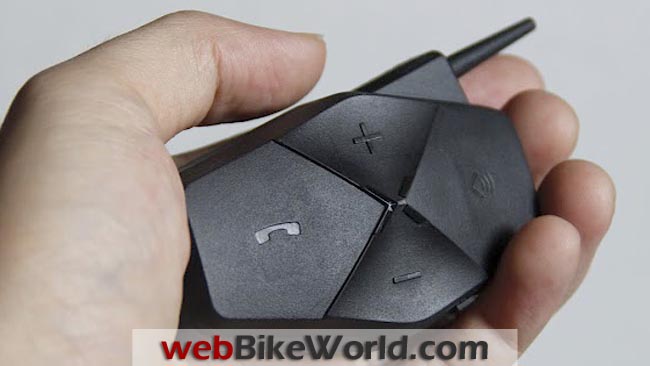
Installation
The basic Vertix Raptor-i intercom kit gives you the intercom unit, a charging cable (micro USB), an adapter and a user guide.
The Raptor-i is a rhomboid-shaped device with a small antenna protruding from the back.
Overall it’s probably one of the nicer-looking intercom units on the market; think somewhere between the slim-line Cardo Scala Rider G9 (review) and bulbous Sena SMH10.
It’s about as big as the latter too, but considerably slimmer, as the body of the Vertix unit is just 2.5 cm (about an inch) at its thickest point.
The build quality seems sturdy enough and, um, plasticky…since it’s mostly made of plastic. A hard shell is covered by rubberised fascia, which carries the buttons and LED indicators.
Vertix eschews hardware mounts for its “EZ Mount” system, which is basically the heavy-duty 3M “DualLock” re-closable fastener system. If you haven’t used this before, it’s like a beefier Velcro or hook-and-loop.
Installation is simple: just clean the mounting location, stick on the bottom strip, then let it cure for an hour.
The beauty of this system is that it will work on all kinds of helmets, even those with a short side rim (like a “Jet”) or flip-up helmets.
The 3M DualLock system is very sturdy and it’s unlikely the unit will be dislodged from your helmet under riding conditions, as it requires significant pressure and a positive locking “click” to mount the intercom to the strip.
There’s also a raised lip around the bottom face of the intercom unit, so it can attach limpet-like to the helmet without any fear of it catching on cables or clothing.
The photos illustrate the Raptor-i, which was easily mounted to my daily helmet, a Shark S900 (review).
Vertix mentions an “angle-of-attack” adjustment in its manual, which is a fancy way of saying that you can lock the intercom module in at different angles of deflection to suit your riding style or position, thanks to the DualLock mounting strip.
Microphone and Speakers
When ordering the Vertix Raptor-i intercom, you can specify an accessories pack (included in the price), depending on the type of helmet you have: a boom mic if you’re using it on a flip-up or open face helmet, while full-face users should go with the wired mic option.
Both options include the same type of in-helmet speaker, with an attachable hooked side of Velcro.
The speakers are pretty slim, about half a centimetre in width. My Shark S900 doesn’t have any speaker cavities, but the speakers still fit without impeding ear space, so those of you with the pre-made cavities should have no problem whatsoever.
One speaker is detachable, which eases to installation process, but it’s little different from any other third-party intercom system really.
Test the position of the unit, stick on the lock strip, place the speakers and mic, then tuck away all the wires into the neck roll — a 10-minute job.
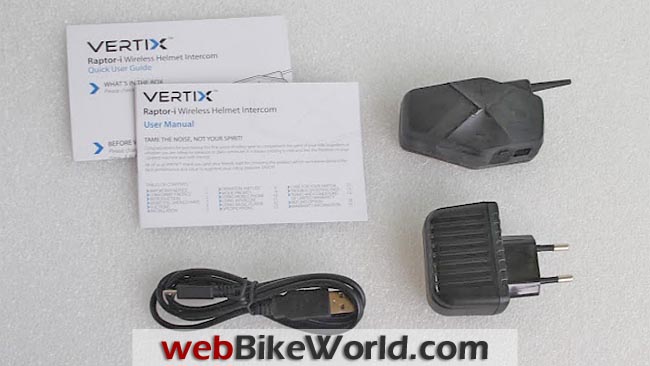
Up and Running
As its form factor suggests, the Vertix Raptor-i controls are simple; again, the concept of it being halfway between the dead-simple Sena and the more complex Scala G9 applies here.
There are two LED indicators — red and blue — and only four buttons to wrangle, each taking one quarter of the unit’s “face”. The four buttons are as follows:
- The main power button, also called the intercom button.
- The phone button.
- The plus button.
- The minus button.
I won’t go into the nitty-gritty of what each does (that’s the manual’s job!) but it’s self-explanatory to a degree. The buttons are mode-dependent; that is, they do different things depending on which operating mode the intercom is in.
What mode is currently engaged depends on what you have connected and its priority, just like any other intercom.
For example, if you’re riding along listening to music — either through music streaming or the FM radio — the plus and minus buttons control the volume (with a long press) or track playback (with a short press).
Pressing the phone button pauses things. It sounds a bit complex explained here in words, but is quite easy to get a handle on with a little practice.


Connectivity
Charging is easy: connect the USB cable and the red light blinks to indicate charging. When the battery is full, the light goes solid. If the battery is running low while using the intercom, the LED flashes.
Holding the power button turns on the intercom (as is standard operating procedure), while holding the button longer from the get-go results in the blue and red lights flashing together to indicate the unit is ready to connect or in pairing mode (again standard for modern Bluetooth intercoms).
Connecting a smart phone is easily done via the usual Bluetooth menu to search for the device.
Linking two Vertix Raptor-i units for intercom service is easy: with both units in pairing mode, press the power button briefly on one unit to pair them, upon which both units flash blue. Pairing is a one-time process, and we had very little trouble establishing connections.
As with all Bluetooth devices, there is the occasional refusal to pair that occurs, but it’s nothing another attempt won’t fix.
The Raptor-i is supposed to work with most devices, although an MP3 player without a visible menu might be tricky to pair.
Another possible drawback is the fact that a GPS unit can only be connected together with a phone if the GPS unit itself supports a phone connection; if not it’s either or.
It’s a minor issue, since the vast majority of stand-alone navigation devices nowadays do pair with a cell phone, but if you own an older device do take note.
Impressions
I don’t typically use an in-helmet speaker set-up because my foam earplugs cut 33 dB of noise and to my mind, boosting speaker output because you can’t hear through the earplugs is simply not logical.
In an aside, the speakers provided with the Raptor-i can put out a maximum of 110 dB, according to the spec sheet, which means they can surely be heard at most legal/sane speeds. Whether that is good for your hearing is another thing, and that goes for all speaker units.
But a test is a test, so I tried the intercom speakers without ear plugs, and the sound quality was very good. Below 70 km/h, all of the outputs (phone, music, intercom) were clear, distortion-free and easy to understand.
Above that speed, things degraded rather quickly, because of wind noise.
But to be fair, I’ve used my Sena SMH10 in identical circumstances and the two are about on the same level in terms of speaker performance under similar conditions.
I currently ride a 2000 Honda CBR 929RR with a double-bubble windscreen and it seems to be a noisy combination since nothing but the best earplugs or in-ear monitors cut enough wind noise to my liking.
In contrast, one of my colleagues tried the Vertix Raptor-i speaker setup on his Fazer 1000 and reported legibility at speeds of up to 140 km/h, most likely thanks to the taller windscreen.
Of course, the considerations of the type of bike you ride, the helmet and earplugs you use, will make the experience differ considerably, but it also holds true for any other intercom set on the market.
I also managed to wrangle a prototype in-ear speaker connector set from Vertix to use (I’ll report on the full-production unit once it arrives) with my preferred pair of in-ear speakers, the Etymotic ER6i and the results were even better.

Riding With the Vertix Raptor-i
With high-speed clarity restored, the automatic volume leveling and noise-cutting technologies earned their keep, applied to all audio inputs or outputs the unit handles.
The unit has four volume levels, although each level is itself automatically adjusted to a degree, so it’s better to think of it as a range rather than a single volume level.
If you’re commuting and generally keeping to a speed around 90-100 km/h (62 MPH) then you won’t have to touch the volume controls — which is why Vertix made the volume setting a long press of the + or – button instead of a short press.
At speeds above 120 km/h, you’ll probably have to bump up the volume a notch, although on the whole I found myself touching the volume controls much less often than with my Sena SMH10 intercom.
Microphone Noise Control
But the real trick up the Vertix sleeve is the noise control on the microphone inputs, and it applies to both intercom and telephone usage too.
After pairing two units, you press the intercom button and the typical full-duplex link is open between them. What’s impressive is the lack of background noise while talking.
Most bikers know that wind noise can be all-obliterating and make casual conversation a big pain.
But with the Vertix it’s possible to hear, and be heard, and high speed (I tested it to around 130 km/h because any faster and it’s no longer time for talk!) without any blasting or roaring coming through, even while accelerating, although engine noise is sometimes apparent.
On my trip to Thailand (report) with the Sena SMH-10 last year (firmware 3.X, not 4.0), anything above 110 km/h generally required near-shouting into the microphone.
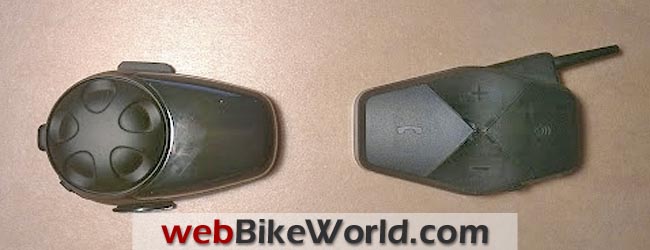
Range and Clarity
The claimed range for the Vertix Raptor-i is about accurate at 800 metres and it’s also dependent on line-of-sight (just as it is with any other Bluetooth intercom), although you have to be one or two bends ahead on a twisty piece of tarmac or blocked by elevations to get completely cut off.
While you should always stop by the roadside to take a phone call, I tested the Bluetooth telephony function at 90 km/h, in the name of science and webBikeWorld of course.
If you use a hands-free set on a motorcycle, most times the other party will be able to tell because of the elevated background noise.
In this case, the noise-reducing technology in the intercom made the caller think I was at a cafeteria.
Noise wasn’t cut completely, but normal conversation was entirely possible without having to raise my voice, and it illustrates that the algorithms employed by Vertix work pretty well indeed.
I have already mentioned the control scheme, which is easy enough to get used to after a day or two of practise.
The ergonomics are good, thanks to the diamond shape of the unit you can easily find the buttons, although pressing them can be hard; the buttons themselves are small, and under skin of the weatherproof rubber outer.
Users wearing insulated gloves might have problems too.
Buttons with larger surface area would be an easy fix, since there’s still some “real estate” on the intercom face.
Using a thumb press was easier, instead of the usual index finger, but the Sena jog dial simply outclasses the Vertix in this aspect.
As with most intercoms, button presses and commands are confirmed or denied by audio cues.
What also took some getting used to is a slight lag between button presses and execution of the command; it’s not a huge lag, but it’s there and makes the learning curve a little higher.
Charging the units with USB is easy, and you can also charge during usage if your bike has the appropriate 12V socket and USB adapter.
I didn’t use the Vertix until the battery was exhausted, but the charge took on a 400 km, six-hour riding day with intercom and music streaming with no qualms.
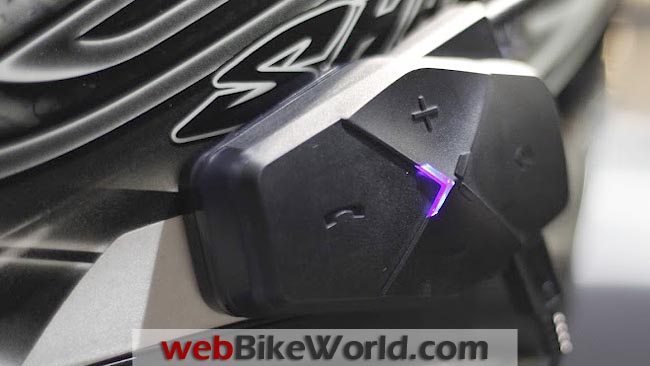
Conclusion
I find myself saying “like most other intercoms” a lot in this review when referring to the Vertix Raptor-i.
So it’s fitting that the major take-away point is that the Vertix does deliver in all major areas of expectation, anything from quality, to mounting and ease of use, as well as functionality.
In terms of audio clarity — both on inputs and outputs — the Vertix Raptor-i was especially impressive.
Together with a list price of SGD198 ($160.00 USD) per unit (for the non-FM, non-upgradeable unit), without shipping, that’s quite a steal.
The only complaints I have are the hard-to-press buttons, and the slight lag, which Vertix says it’s working on in future firmware updates along with another add-on which could help make the unit even easier to use.
Along with the in-ear adaptor and headset, we will shortly be receiving an infra-red, handlebar-mounted, joypad-style remote control, which, if works well, could be just the thing for the tricky button presses. Look for a follow-up review of those soon.
|
wBW Review: Vertix Raptor-i Intercom
|
|
|---|---|
| Manufacturer: Vertix | List Price (2012): $185.00 |
| Colours: Black. | Made In: China |
| Sizes: N/A | Review Date: October 2012 |
NOTE: The webBikeWorld evaluators wear properly fitted ear plugs for intercom evaluations. This is reflected in the opinions on sound quality and speaker volume. Your experience may differ. Always protect your hearing when riding a motorcycle (more).
Owner Comments and Feedback
See details on submitting comments.


